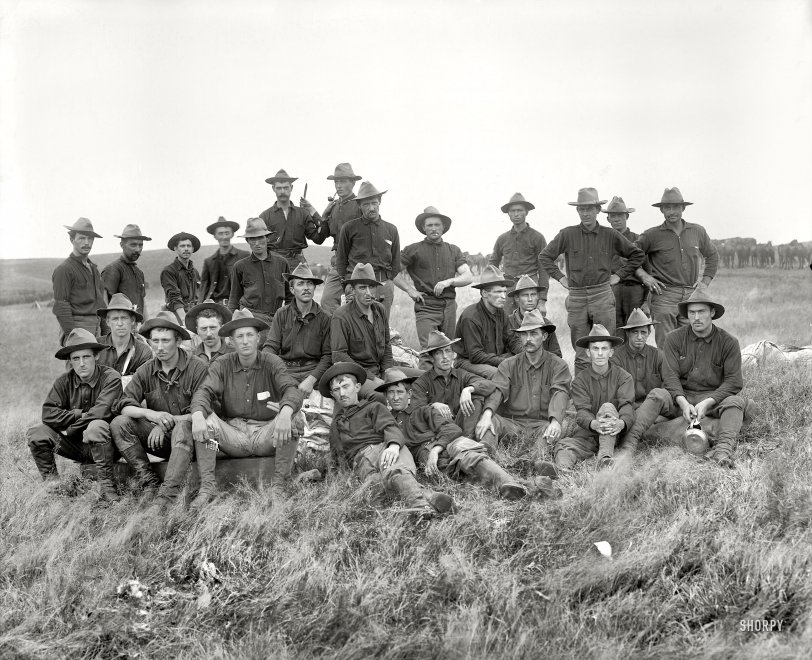


Framed or unframed, desk size to sofa size, printed by us in Arizona and Alabama since 2007. Explore now.
Shorpy is funded by you. Patreon contributors get an ad-free experience.
Learn more.

- Texas Flyer wanted
- Just a Year Too Soon
- WWII -- Replacing men with women at the railroad crossing.
- Yes, Icing
- You kids drive me nuts!
- NOT An Easy Job
- I wonder
- Just add window boxes
- Icing Platform?
- Indiana Harbor Belt abides
- Freezing haze
- Corrections (for those who care)
- C&NW at Nelson
- Fallen Flags
- A dangerous job made worse
- Water Stop
- Passenger trains have right of way over freights?
- Coal
- Never ceases to amaze me.
- Still chuggin' (in model form)
- Great shot
- Westerly Breeze
- For the men, a trapeze
- Tickled
- Sense of loneliness ...
- 2 cents
- Charm City
- What an Outrage
- Brighton Park
- Catenary Supports
Print Emporium
Back From Cuba: 1898

Long Island, New York, circa 1898. "Boys of the 71st N.Y. at Montauk Point after return from Cuba." Detroit Publishing Company glass negative. View full size.
Krag-Jorgenson rifle
The Krag was by far not the worst weapon used by the US. While it was shortlived, it gave good service, and was a favorite of the Army shooting teams who BTW hated the 1903 Springfield when it was first introduced. What killed the Krag was the fact that it could not use a charger clip, and the action was not as strong as the Mauser.
Half in Havana
The guy with the knife looks like his mind hasn't quite made it back from Cuba yet, if ever.
Spanish American War rifles
Anonymous Tipster mentioned that his grandfather's unit was using the .45-70 Springfield rifles. That was the 1888 Springfield with the combined bayonet and cleaning rod. Most Guard units were equipped with that rifle while most regular units were equipped with the Krag-Jorgenson, arguably the worst rifle that the US Army was ever equipped with. It was slower to load than the Mauser rifle that the Spanish were equipped with and had a lower velocity bullet. In the assault on Santiago, the Spanish defenders numbered about 750; they inflicted 1,400 casualties (killed or wounded) on the Americans who had 6,600 troops and was supported by artillery and Gatling guns. That's a 21.2% casualty rate.
Mmmm Lunch!
I wonder how old that piece of hardtack is that the one fellow is chewing on. I've read that some Spanish American War hardtack was actually stamped "Remember the Maine." Another fellow is holding his mess knife like a weapon. I assume it's a mess knife, since a third fellow is holding a mess kit.
The Bugs of War
The National Guard militias of various states mustered and trained far more troops than the Government needed (or wanted), and many soldiers found themselves shipped to camps in the deep South, Florida or Hawaii, where they collapsed in the heat, were eaten alive by insects and fell victim to typhus and like diseases from the miserable water supply. More soldiers were felled by disease than bullets.
Coming of Age
These guys appear to be much older that the WW2/Korean Conflict/Vietnam Era GIs. Was it more of a profession then? Were they hold overs from the post Civil War years? Or did they just age more quickly?
"A splendid little war" - NOT
The scowls on the volunteers' faces are understandable. In the Spanish-American War the 71st NY was poorly trained, poorly armed, and (most notably) poorly led. When they were not stuck for days in malarial settings waiting to get to or from Cuba, some of their officers were leading them into dead ends during the war's greatest land battle. As Governor Teddy Roosevelt would write of the rank-and-file in 1899 when approving an inquiry's findings of incompetence by several senior officers during that battle, "save when paralyzed by bad leadership they were as able as they were eager to do honor to the glorious traditions of the American volunteer service."
Granddad in the 71st
My grandfather served in Cuba with the 71st and his father before him served with the regiment during the Civil War.
When they shipped home from Cuba the were landed at Montauk, quarantined to recover from various diseases contracted in service before being allowed to enter a homecoming event in New York City. The were sent home on a special Long Island Railroad train after some weeks.
A similar group picture with him was on my grandfather's parlor mantel back in the 1940s.
In camp before shipping out to Cuba they use to shout "Remember the Maine, to Hell with Spain" to build fighting spirit. They had black powder .45-70 Springfield rifles, a fairly new issue item to them, as they had used .50-70 Remingtons until about six months before the War.
























On Shorpy:
Today’s Top 5